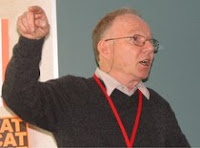Dr. Adam Sarty of Saint Marys University was one of the 10 recipients of a prestigious 3M STLHE (Society for Teaching and Learning in Higher Education) teaching fellowship. This was awarded at the STLHE annual conference held at the University of Saskatchewan June 15-18.
The 3M STLHE citation for Adam Sarty in part reads "He is a model of teaching excellence and educational leadership....Few faculty, in any institution, have had such a tremendous impact in so short a period of time....His students express it this way: 'Humourous! Enthusiastic! Knowledgeable! Amazing! Best teacher ever!'....Over time, and in many ways, Adam Sarty has shown that he is an exceptional communicator, a gifted teacher and an excellent role model."
One of Canada's most accomplished and energetic university physics teachers, Adam is a leader in a number of aspect of physics education. He is well known for the effective use of clickers in interactive, peer instruction settings in large introductory classes. He has been a proponent of these techniques locally, regionally and nationally, and has spoken at many Atlantic universities after he won the Atlantic Association of Universities Educational Leadership Award in 2008.
He is one of the most energetic proponents of physics outreach, and each year does demonstrations at countless schools and public settings. In fact, he even has been known to do physics demonstration shows along the street in his neighbourhood. Saint Marys have a web page which describes the Adam Sarty physics show, and gives instructions on how to apply to have the show at your school.
His reach goes well beyond Nova Scotia or even Atlantic Canada, however. He played a key role in the development of the Saint Marys video physics resource that draws a huge audience from around the world, Adam personally appearing in many of these. If you are not familiar with this wonderful resource, check out the video demonstration website.
Adam was the 2008 winner of the Canadian Association of Physicists Medal for Excellence in Undergraduate Teaching, and the citation reads in part "...for inspiring his students to love learning physics, successfully implementing innovative teaching technologies and sharing the beauty of the discipline, through his dedication to physics education."
More details on Adam Sarty, his accomplishments and the 3M STLHE award are available in the university press release. Congratulations to Adam on this most deserved honour.
Image from Saint Marys University.






